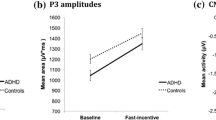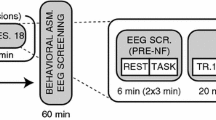Abstract
This study evaluated the neuropsychological performance of adults with and without Attention Deficit Hyperactivity Disorder (ADHD) during the Paced Auditory Serial Addition Test (PASAT), Wisconsin Card Sorting Test: Computerized Version 3 (WCST), and the Integrated Visual and Auditory Continuous Performance Test (IVA). Quantitative electroencephalographic (QEEG) data were also collected during task performance to examine differences in cortical activity between groups and tasks. Results suggest that adults with ADHD demonstrated lower levels of performance on the PASAT and IVA, tasks that involve working memory and processing speed, and sustained attention, respectively. Adults with ADHD also had more upper alpha activity during the IVA. Lastly, for the ADHD group, an increased theta/beta ratio during the IVA was significantly related to poorer attentional performance. The current results support reinforcing specific types of cortical activity though EEG operant conditioning (neurofeedback) as a treatment option in adults with ADHD.
Similar content being viewed by others
References
American Psychiatric Association. (1994). Diagnostic and statistical manual of mental disorders (4th ed.). Washington, DC: American Psychiatric Association.
Barbarin, O. A., & Soler, R. E. (1993). Behavioral, emotional, and academic adjustment in a national probability sample of African American children: Effects of age, gender, and family structure. Journal of Black Psychology, 19(4), 423–446.
Barkley, R. A. (1990). Attention-deficit hyperactivity disorder: A handbook for diagnosis and treatment. New York: Guilford Press.
Barkley, R. A. (1998). Developmental course, adult outcome, and clinic-referred ADHD adults. In R. A. Barkley (Ed.), Attention-deficit hyperactivity disorder: A handbook for diagnosis and treatment (2nd ed., pp. 186–224). New York: The Guilford Press.
Berg, E. A. (1948). A simple objective test for measuring flexibility in thinking. Journal of General Psychology, 39, 15–22.
Biggs, S. H. (1995). Neuropsychological and psychoeducational testing in the evaluation of the ADD adult. In K. G. Nadeau (Ed.), A comprehensive guide to attention deficit disorder in adults (pp. 109–131). New York: Brunner/Mazel.
Brittain, J. L., La Marche, J. A., Reeder, K. P., Roth, D. L., & Boll, T. J. (1991). Effects of age and IQ on Paced Auditory Serial Addition Task (PASAT) performance. The Clinical Neuropsychologist, 5(2), 163–175.
Castellanos, F. X. (2001). Neuroimaging studies of ADHD. In M. V. Solanto, A. F. T. Arnsten, & F. X. Castellanos (Eds.), Stimulant Drugs and ADHD: Basic and Clinical Neuroscience. New York: Oxford University Press.
Chabot, R. J., Merkin, H., Wood, L. M., Davenport, T. L., & Serfontein, G. (1996). Sensitivity and specificity of QEEG in children with attention deficit or specific developmental learning disorders. Clinical Electroencephalography, 27(1), 26–34.
Chabot, R. J., & Serfontein, G. (1996). Quantitative electroencephalographic profiles of children with attention deficit disorder. Biological Psychiatry, 40(10), 951–963.
Clarke, A. R., Barry, R. J., McCarthy, R., & Selikowitz, M. (2001). EEG-defined subtypes of children with attention-deficit/hyperactivity disorder. Clinical Neurophysiology, 112(11), 2098–2105.
Duffy, F. H. (1994). The role of quantified electroencephalography in psychological research. In G. Dawson & K. W. Fischer (Eds.), Human behavior and the developing brain (pp. 93–133). New York: Guilford Press.
Egner, T., & Gruzelier, J. H. (2001). Learned self-regulation of EEG frequency components affects attention and event-related brain potentials in humans. NeuroReport, 12(18), 4155–4159.
Egner, T., & Gruzelier, J. H. (2004). EEG biofeedback of low beta band components: frequency-specific effects on variables of attention and event-related brain potentials. Clinical Neurophysiology, 115(1), 131–139.
Grant, D. A., & Berg, E. A. (1948). A behavioral analysis of degree of reinforcement and ease of shifting to new responses in a Weigl-type card sorting problem. Journal of Experimental Psychology, 34, 404–411.
Gronwall, D. M. A. (1977). Paced Auditory Serial Addition Task: A measure of recovery from concussion. Perceptual and Motor Skills, 44, 367–373.
Heaton, R. K., Chelune, G. J., Talley, J. L., Kay, G. G., & Curtiss, G. (1993). Wisconsin Card Sorting Test manual: Revised and expanded. Odessa, FL: Psychological Assessment Resources, Inc.
Heaton, R. K., Thompson, J. A., & Gomez, E. (1999). Wisconsin Card Sorting Test: Computer version 3 for Windows research edition manual. Odessa, FL: Psychological Assessment Resources, Inc.
Jasper, H. H. (1958). The ten twenty electrode system of the international federation. Electroencephalography and Clinical Neurophysiology, 10, 371–375.
Levin, H. S., Mattis, S., Ruff, R. M., Eisenberg, H. M., Marshall, L. F., Tabaddor, K., et al. (1987). Neurobehavioral outcome following minor head injury: a three-center study. Journal of Neurosurgery, 66(2), 234–243.
Lexicor Medical Technology. (1992). NeuroLexTM software for EEG—Data acquisition & analysis [Computer software] (Version 1.51). Denver, CO: Lexicor Medical Technology.
Lexicor Medical Technology. (1996). Exporter quantitative EEG export program [Computer software] (Version 1.2). Denver, CO: Lexicor Medical Technology.
Lubar, J. F. (1991). Discourse on the development of EEG diagnostics and biofeedback for attention-deficit/hyperactivity disorders. Biofeedback and Self Regulation, 16(3), 201–225.
Lubar, J. F. (1995). Neurofeedback for the management of attention-deficit/hyperactivity disorders. In M. S. Schwartz (Ed.), Biofeedback: A practitioner's guide (pp. 493–522). New York: Guilford Press.
Mann, C. A., Lubar, J. F., Zimmerman, A. W., Miller, C. A., & Muenchen, R. A. (1992). Quantitative analysis of EEG in boys with attention-deficit-hyperactivity disorder: Controlled study with clinical implications. Pediatric Neurology, 8(1), 30–36.
Monastra, V. J., Lubar, J. F., Linden, M., VanDeusen, P., Green, G., Wing, W., et al. (1999). Assessing attention deficit hyperactivity disorder via quantitative electroencephalography: An initial validation study. Neuropsychology, 13(3), 424–433.
Monastra, V. J., Monastra, D. M., & George, S. (2002). The effects of stimulant therapy, EEG biofeedback, and parenting style on the primary symptoms of attention-deficit/hyperactivity disorder. Applied Psychophysiology and Biofeedback, 27(4), 231–249.
Riccio, C. A., Hynd, G. W., Cohen, M. J., & Gonzalez, J. J. (1993). Neurological basis of attention deficit hyperactivity disorder. Exceptional Children, 60(2), 118–124.
Sandford, J. A. (1995). Intermediate Visual and Auditory continuous performance test interpretation manual (Version 1.2 ed.). Richmond, VA: Sandford, Joseph A.
Schweitzer, J. B., Faber, T. L., Grafton, S. T., Tune, L. E., Hoffman, J. M., & Kilts, C. D. (2000). Alterations in the functional anatomy of working memory in adult attention deficit hyperactivity disorder. American Journal of Psychiatry, 157(2), 278–280.
Seidman, L. J., Biederman, J., Weber, W., Hatch, M., & Faraone, S. V. (1998). Neuropsychological function in adults with attention-deficit hyperactivity disorder. Biological Psychiatry, 44(4), 260–268.
Shealey, A. H. (1994). Attention-deficit hyperactivity disorder—Etiology, diagnosis, and management. Journal of Child and Adolescent Psychiatric Nursing, 7(2), 24–36.
Swanson, J., Castellanos, F. X., Murias, M., LaHoste, G., & Kennedy, J. (1998). Cognitive neuroscience of attention deficit hyperactivity disorder and hyperkinetic disorder. Current Opinion in Neurobiology, 8, 263–271.
Tinius, T. P. (2003). The Intermediate Visual and Auditory Continuous Performance Test as a neuropsychological measure. Archives of Clinical Neuropsychology, 18(2), 199–214.
Weinfurt, K. P. (1995). Multivariate analysis of variance. In L. G. Grimm & P. R. Yarnold (Eds.), Reading and understanding multivariate statistics (pp. 245–276). Washington, DC: American Psychological Association.
Weiss, R. E., Stein, M. A., Trommer, B., & Refetoff, S. (1993). Attention-deficit hyperactivity disorder and thyroid function. The Journal of Pediatrics, 123(4), 539–545.
Wender, P. H. (1995). Attention-deficit hyperactivity disorder in adults. New York: Oxford University Press.
Woods, S. P., Lovejoy, D. W., Stutts, M. L., Ball, J. D., & Fals-Stewart, W. (2002). Comparative efficiency of a discrepancy analysis for the classification of Attention-Deficit/Hyperactivity Disorder in adults. Archives of Clinical Neuropsychology, 17(4), 351–369.
Author information
Authors and Affiliations
Corresponding author
Additional information
This paper is based largely in part on a dissertation by J. Noland White in partial fulfillment of the requirements of his doctoral program at The University of Tennessee. Portions of this study have been presented in summary form at several professional conferences.
Rights and permissions
About this article
Cite this article
White, J.N., Hutchens, T.A. & Lubar, J.F. Quantitative EEG Assessment During Neuropsychological Task Performance in Adults with Attention Deficit Hyperactivity Disorder. J Adult Dev 12, 113–121 (2005). https://doi.org/10.1007/s10804-005-7027-7
Issue Date:
DOI: https://doi.org/10.1007/s10804-005-7027-7




